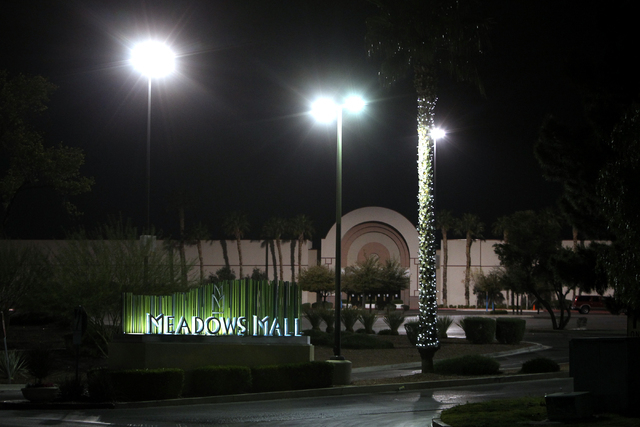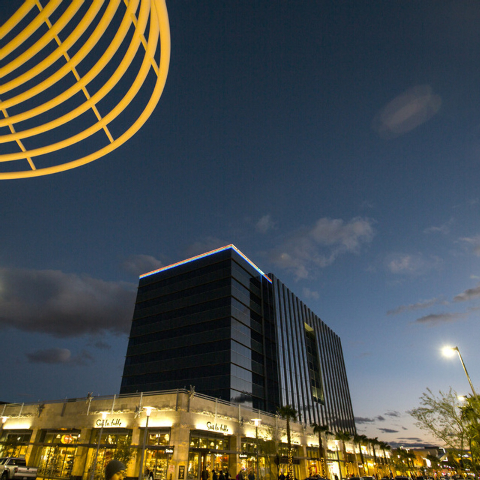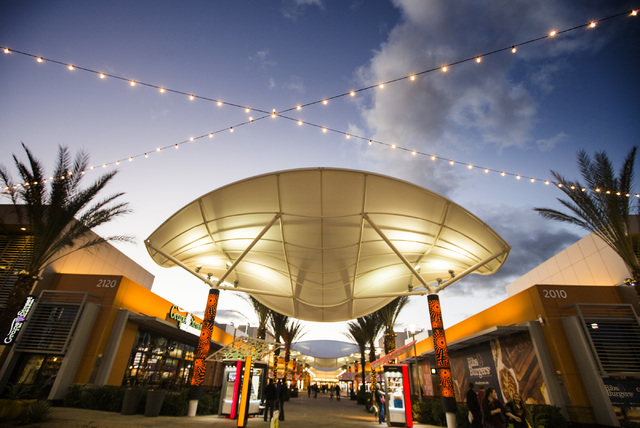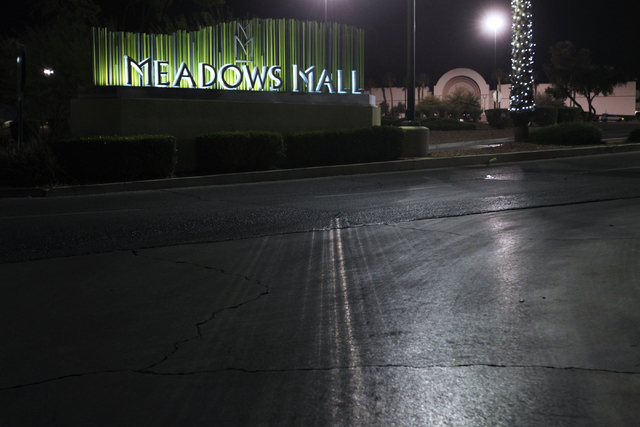The Meadows Mall endures as the odd mall out
George Okinaka can’t remember the last time he visited the Meadows mall.
For the native Las Vegan, now a senior retail associate with commercial brokerage Voit Real Estate Services, the mall was a place to go when he was growing up in the 1980s and ’90s.
But it’s been “10-plus years” since he set foot in the mall at U.S. Highway 95 and Valley View Boulevard. Today, Okinaka sticks with Galleria at Sunset, near his Henderson home, and Town Square, a few minutes to the west at Las Vegas Boulevard and the 215 Beltway.
The problem for the Meadows is that there are tens of thousands of Okinakas across the Las Vegas Valley. With regional shopping centers proliferating, the Meadows is becoming an odd mall out — the shopping center without a distinct personality or demographic segment. As a result, retail experts say, the mall faces a crossroads at which it must soon chart a new direction.
“There’s less of a reason today to go to the Meadows mall unless you live in that immediate area, and it’s out of sight, out of mind for a lot of people,” Okinaka said.
Executives with the Meadows, owned by Chicago retail giant General Growth Properties, say the shopping center is doing well. Less than 5 percent of its 945,000 square feet is empty — a healthy vacancy rate by any standard. Leasing agents have also added new stores in recent months, including ANGL, Charming Charlie, Crazy 8, U.S. Polo Assn. and Verizon.
“Meadows mall has served the Las Vegas community for 37 years as one of the valley’s largest retail centers,” said Mark Thorsen, the Meadows’ general manager. “Today, Meadows mall is more than 95 percent leased and like the community and population we serve, we continue to evolve and better refine our retail mix to reflect changing consumer needs and preferences.
“We have enjoyed being a part of the community for nearly four decades, and we look forward to many more years serving the families of the valley’s west side.”
New tenants or not, the Meadows is in a class of malls struggling nationally to keep business from slipping away to upscale peers. And in Las Vegas, the mall has deep competition from centers with more defined niches.
VISITORS HELP POWER STRIP MALLS
Malls on the Strip, including General Growth’s Fashion Show and Simon Property Group’s Forum Shops at Caesars, are some of the country’s highest-grossing centers thanks to an annual stream of more than 40 million visitors to the resort corridor.
Forest City Enterprises’ 1.5 million-square-foot Town Square is the just-off-Strip spot where Las Vegans and visitors mix, with a shopper profile that’s 65 percent local and 35 percent tourist.
Galleria at Sunset, on Sunset Road near U.S. Highway 95, is the only enclosed regional mall in Henderson, which means it has the affluent Green Valley and Green Valley Ranch markets pretty much to itself. The shopping center is expanding, adding 30,000 square feet and six restaurants to its 1.2 million-square-foot base.
The 1.2 million-square-foot Boulevard on Maryland Parkway is forging a working-class identity under the Sansone Cos., the Las Vegas developer that bought it in 2013.
Then there’s the shopping district at Downtown Summerlin. When it opened in October, Downtown Summerlin became both the largest locals-oriented center, at 1.6 million square feet, and perhaps the city’s highest-end suburban center, with tenants including Apple, Art of Shaving, Boston Proper, Golfsmith, Wolfgang Puck and the upscale Andiron steakhouse from local restaurateurs Elizabeth Blau and Kim Canteenwalla.
The other shopping centers “really leave Meadows in kind of a no-man’s land with respect to retailers and higher-end demographics moving away from the area,” said Ted Baker, a retail consultant with local commercial brokerage NewMarket Advisors.
On paper, at least, Downtown Summerlin is the Meadows’ biggest threat. General Growth outlines a trade area for the Meadows that spans the city’s north and west sides, from Centennial Hills in the far northwest down almost to the southern portion of the beltway.
The truth is, residents of Summerlin and northwest Las Vegas haven’t shopped at the Meadows “in some time,” said Matt Bear, a vice president with commercial real estate brokerage CBRE Las Vegas. They’ve been going instead to Fashion Show and Town Square.
Older, enclosed malls have been in decline nationally for years, even as newer, high-end outdoor centers have surged — the result of factors including Internet sales and changing demographics. Enclosed malls also suffer because their operating costs for tenants are several times higher than expenses at outdoor centers, Baker said.
“B-quality malls are searching for their identity,” Bear said. “Long-term, the Internet is going to continue to hurt some merchants and real estate. For that reason, it’s safer for retailers and developers to invest in newer projects in denser or more affluent areas. There’s always a march to quality or safety.”
FOR NOW, A SOLID B
So what keeps a mall from safe Class A territory? Real estate consulting firm Green Street Advisors defines A malls as dominant malls in top markets, filled with luxury tenants, and blessed with good demographics, high sales productivity and even a retailer waiting list.
Class B centers have generally stable sales productivity, a mix of national and regional tenants, solid occupancy and status as either the best mall in a small market or the third-best mall in a five-mall town. The Meadows qualifies, Bear said.
But Meadows is close to claiming at least one attribute of Class C or D malls: Anchor vacancies.
Weeks after the Meadows’ anchor Dillard’s opened its Downtown Summerlin store, the retailer shuttered the first floor of its 180,000-square-foot Meadows location, and converted the second floor to a clearance outlet for unsold merchandise from other regional Dillard’s stores.
The Dillard’s move has a “direct correlation with their sales numbers there, and the demographic that’s coming to shop at the mall,” said Nelson Tressler, executive managing director of commercial brokerage Newmark Grubb Knight Frank in Las Vegas.
Consider those demographics: The ZIP codes that surround the mall have household incomes below the citywide median of $45,670. In 89102, the 2013 median was $29,781, according to statistics from the Clark County Comprehensive Planning Department. That dropped to $27,864 in 89106, and was $40,971 in 89107, and $39,707 in 89108.
In contrast, incomes ranged from $46,982 in 89117 to $81,353 in 89138, two suburban areas around Downtown Summerlin.
Dillard’s wouldn’t comment further on its decision to pare its mall presence, or the future of the rest of the store.
But “once you start losing tenants, especially an anchor, it can start to be a death spiral,” said Alex Goldfarb, a managing director specializing in retail equity research for New York investment banking firm Sandler O’Neill + Partners.
It doesn’t help that two of the Meadows’ other tenants — J.C. Penney and Sears — are also “struggling in today’s environment to gain an identity that connects with consumers,” Tressler said.
“Those two anchors have a lot to do with the mall’s identity,” he said.
Still, the Meadows has plenty of promise.
“There’s still a lot of population in the area, and incomes are certainly good enough,” Bear said. “It’s a working trade area.”
Also in the Meadows’ favor are a highly visible location at the intersection of a freeway and a major through street, as well as “tremendous” housing density, Baker said.
“And for every demographic, there’s a retailer selling products, so over time, the mall will come to equilibrium,” he said.
Getting there will likely require change.
ASSEMBLING A STRONG LINEUP
Revamping the mall’s tenant lineup will be essential, observers said.
Any mall “has to really cater to who its customer is,” Okinaka said.
Okinaka pointed to the Boulevard Mall as one model.
Sansone Cos. bought the distressed mall for $54.5 million in 2013 after former owner the Rouse Co. decided to surrender it rather than try to support its $168 million debt. In less than two years, Sansone has pushed vacancy from around 30 percent to less than 10 percent, bringing in unconventional tenants such as a Nevada Health Link enrollment store and the Hispanic Museum of Nevada. There’s also a store that sells dresses for quinceañera parties, or celebrations of a girl’s 15th birthday in the Hispanic culture.
Sansone has also been eyeing converting the mall’s empty Dillard’s space to an office call center. A New York company won unanimous support on March 19 from the governor’s economic development office for nearly $300,000 in tax-abatement incentives to open a call center there that would employ up to 1,000 people. The company, Sutherland Global Services, is considering other markets, too.
“We feel this could be a very strong blue-collar mall catering to the working class,” Roland Sansone, president of the Sansone Cos., told the Las Vegas Review-Journal in March 2014.
Other experts pointed to sit-down restaurants coming to both The Boulevard and Galleria at Sunset. The eateries, which line the outsides of the centers and open onto parking lots and streets, break up massive exterior walls and “help pull people in,” Tressler said.
Plus, mall operators in other markets are turning to retailers that typically gravitate toward neighborhood power centers.
Paradise Valley Mall in Phoenix enticed Costco Wholesale Corp. in 2008 to open the Issaquah, Wash.-based retailer’s first regional-mall location. Destination stores, such as outdoor-recreation retailer Cabela’s, might also provide a boost, Tressler said.
The Meadows, which was renovated in 1998 and 2005, could also use another face-lift for its dated, “tired” exterior of colorless brick, he said.
Ultimately, a new owner may be making those decisions.
General Growth spun off 30 Class B malls to Rouse in 2012, Goldfarb noted, and the company “continues to prune.”
“Clearly, if you look at their strategy, they want to own top-tier malls and street retail,” he said. “All of the Class A mall (real estate investment trusts) are divesting themselves of their lower-tier assets.”
Whether General Growth keeps or sells the Meadows, local observers said they expect the center to stick around for the long haul.
“It absolutely will survive. It just needs help to be brought back to life,” Bear said. “It’s not a declining trade area, just an aging one. And that’s OK.”
Contact Jennifer Robison at jrobison@reviewjournal.com. Find her on Twitter: @J_Robison1.























